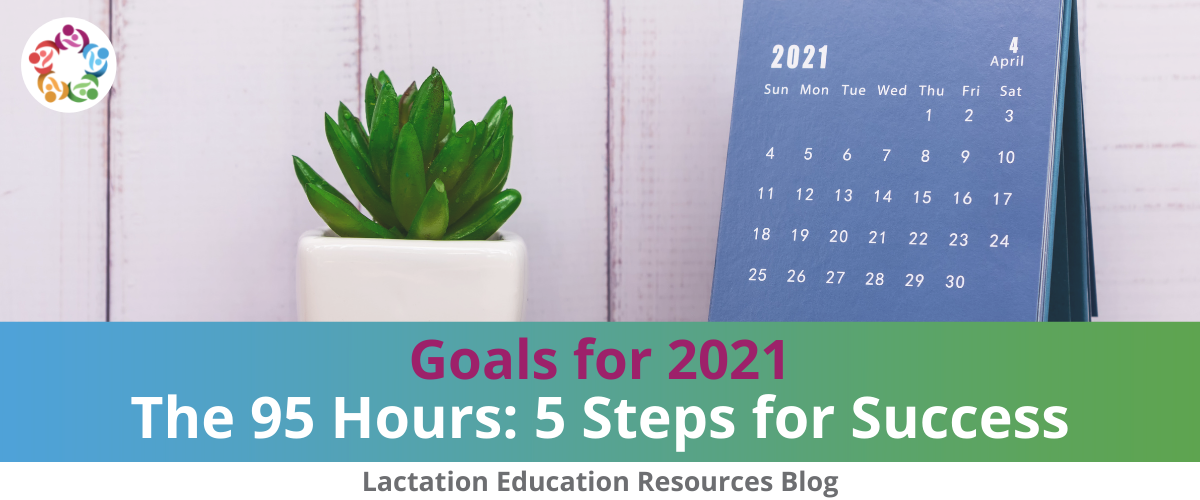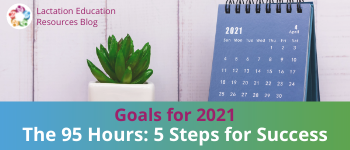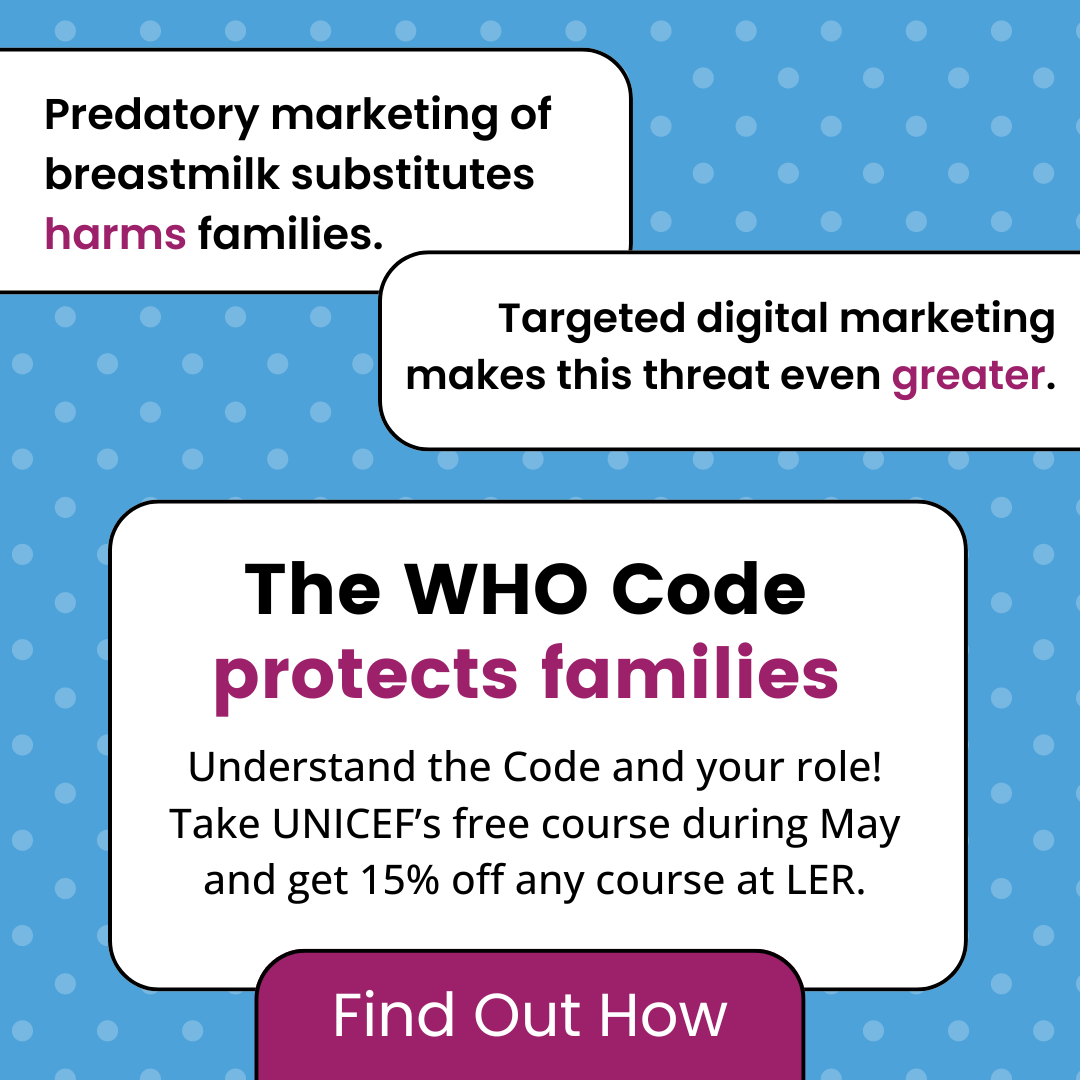Goals for 2021 The 95 Hours: 5 Steps for Success

Ninety-five hours of lactation-specific education … in some ways, it’s the heart and soul of your preparation for the IBCLC exam.
Your ability to answer the 175 questions you face in the exam will depend in large part on what you learn during this part of your training.
Welcome back to Goals 2021, a blog series where we examine the steps on the journey to IBCLC certification, so you can figure out which ones make sense for you to take this year.
In this post, we’ll talk about ways to get your 95 hours of lactation-specific education.
Angela Love-Zaranka, BA, IBCLC, RLC, Program Director at Lactation Education Resources (LER), served on the IBLCE Board from 2006 to 2012 and sat on IBLCE committees until 2015.
Read on for her five steps to success with lactation-specific education.
Step One: Know the Detailed Content Outline. Published by the International Board of Lactation Consultant Examiners (IBLCE), this document lays out the seven core areas covered by the exam.
It also lists the detailed topics covered under each area.
And, it tells you how many items on the exam will come from each area.
For example, topic area six (Techniques) tells you that you will be tested on effective milk transfer, the first hour, latching, managing supply, milk expression, positioning, refusal of breast and bottle, skin-to-skin and kangaroo care, and test weighing.
Detailed? Yes! And that is good news for you.
If you’re familiar with the Detailed Content Outline, nothing in the exam will come as a surprise.
Access the outline here.
Step Two: Know your strengths and weaknesses. Have you breastfed or chestfed your own twins? Nursed a toddler, or counseled parents on weaning? Or maybe you’ve never known a nursing toddler, but you’ve worked for years in the NICU, so you’re intimately familiar with premature infants.
Going into your lactation-specific learning, it’s really helpful to assess your own base of knowledge against the Detailed Content Outline, asking yourself what you already know and what you will need to learn the most about.
This will help you focus your efforts where you need them the most.
Step Three: Comprehensive course or ala carte? Now it’s time to make a decision.
There are two basic ways to obtain 95 hours of lactation-specific education.
You can sign up for a comprehensive course, typically through an online organization, like the courses offered by LER here:
When you complete a comprehensive course through a good provider, you can feel confident that everything in the Detailed Content Outline will be covered—it’s one stop shopping.
But you don’t have to do it that way.
You can also use the Detailed Content Outline to plan your own educational content, drawing on virtual and in-person seminars, conferences, individual study modules, and courses.
Your choice may depend on your budget, your timeframe, access to learning opportunities, and comfort level with creating your own scope and sequence. You can purchase single courses from LER here or make your own bundle with just the courses you need here.
Step Four: Comprehensive Course Success. If you choose to take a comprehensive course, there are a few steps you can take to get the most out of your hard work.
First, be strategic with time.
“Figure out exactly how long you will have access to the course materials,” Love-Zaranka says. “For example, at LER, you have access for one year.”
Based on when you need to apply for the exam, work your way backwards and plan your approach. How many hours a week can you devote to your course? Love-Zaranka suggests slating them into your planner first each week—otherwise, life tends to crowd them out.
Strategize by topic, planning to spend more time with the areas you are least familiar with and go a little faster with the ones you know well.
Lastly, remember that you can continue to study in the months after you apply.
Love-Zaranka has seen many students begin their course very slowly, taking detailed notes on each lecture … only to realize that time is running out. Don’t panic, she says. “You may need to go through it a little faster the first time, and that’s okay,” she says. “
Step Five: Ala Carte Advice. What if you decide not to take a comprehensive course?
Love-Zaranka recommends starting with the Detailed Content Outline and creating a spreadsheet to plan and document your studies in each content area.
“The primary challenge, when you go this route, is making sure you’re hitting every single aspect of the Detailed Content Outline,” she says.
Creating a spreadsheet allows you to plug in the work you do as you do it, so you can make sure you’re hitting all the areas.
“For example, let’s say you attend a conference and it covers latch and positioning for three hours,” Love-Zaranka says. “Great! You can check that off on your spreadsheet, and document the hours spent.”
Also, be sure to obtain a certificate whenever you attend a conference or complete a class. “You don’t need a CERP certificate or a CEU certificate. You just need a certificate of attendance that says the date and the topic,” she adds.
How do you evaluate the quality of a course or conference, to make sure the information you’re learning is accurate and up to date?
“You do need to be careful,” Love-Zaranka says. “I heard, for example, of someone who took a course on breastfeeding in the NICU, and the course taught that babies had to be able to take a bottle before they could try to breastfeed or chestfeed. That is outdated and inaccurate information.”
The best insurance? Look at the credentials of the people teaching the class, and/or the people who created the course. “Make sure you see someone with an IBCLC or a CBS,” she says.
To find course and conference offerings, Love-Zaranka suggests checking with the breastfeeding coalitions in your country or area to find out what they have to offer. Connect with others in the field and listen to where they find the best information.
Many institutions also offer access to breastfeeding grand rounds, in person and virtually. LER also offers individual courses you can use to fill in the gaps in your learning.
Lastly, just like with a comprehensive course, if you’re charting your own course with lactation-specific education, Love-Zaranka urges you to tailor your work to your own knowledge areas.
“Where do you need to focus more?” she asks. “Find ways to emphasize those content areas.”
Past blogs in the series:
For upcoming exam dates and to tailor your own timetable, see the first post in this series,here
To learn more about how to meet the health sciences course requirements, visit here.

Ninety-five hours of lactation-specific education … in some ways, it’s the heart and soul of your preparation for the IBCLC exam.
Your ability to answer the 175 questions you face in the exam will depend in large part on what you learn during this part of your training.
Welcome back to Goals 2021, a blog series where we examine the steps on the journey to IBCLC certification, so you can figure out which ones make sense for you to take this year.
In this post, we’ll talk about ways to get your 95 hours of lactation-specific education.
Angela Love-Zaranka, BA, IBCLC, RLC, Program Director at Lactation Education Resources (LER), served on the IBLCE Board from 2006 to 2012 and sat on IBLCE committees until 2015.
Read on for her five steps to success with lactation-specific education.
Step One: Know the Detailed Content Outline. Published by the International Board of Lactation Consultant Examiners (IBLCE), this document lays out the seven core areas covered by the exam.
It also lists the detailed topics covered under each area.
And, it tells you how many items on the exam will come from each area.
For example, topic area six (Techniques) tells you that you will be tested on effective milk transfer, the first hour, latching, managing supply, milk expression, positioning, refusal of breast and bottle, skin-to-skin and kangaroo care, and test weighing.
Detailed? Yes! And that is good news for you.
If you’re familiar with the Detailed Content Outline, nothing in the exam will come as a surprise.
Access the outline here.
Step Two: Know your strengths and weaknesses. Have you breastfed or chestfed your own twins? Nursed a toddler, or counseled parents on weaning? Or maybe you’ve never known a nursing toddler, but you’ve worked for years in the NICU, so you’re intimately familiar with premature infants.
Going into your lactation-specific learning, it’s really helpful to assess your own base of knowledge against the Detailed Content Outline, asking yourself what you already know and what you will need to learn the most about.
This will help you focus your efforts where you need them the most.
Step Three: Comprehensive course or ala carte? Now it’s time to make a decision.
There are two basic ways to obtain 95 hours of lactation-specific education.
You can sign up for a comprehensive course, typically through an online organization, like the courses offered by LER here:
When you complete a comprehensive course through a good provider, you can feel confident that everything in the Detailed Content Outline will be covered—it’s one stop shopping.
But you don’t have to do it that way.
You can also use the Detailed Content Outline to plan your own educational content, drawing on virtual and in-person seminars, conferences, individual study modules, and courses.
Your choice may depend on your budget, your timeframe, access to learning opportunities, and comfort level with creating your own scope and sequence. You can purchase single courses from LER here or make your own bundle with just the courses you need here.
Step Four: Comprehensive Course Success. If you choose to take a comprehensive course, there are a few steps you can take to get the most out of your hard work.
First, be strategic with time.
“Figure out exactly how long you will have access to the course materials,” Love-Zaranka says. “For example, at LER, you have access for one year.”
Based on when you need to apply for the exam, work your way backwards and plan your approach. How many hours a week can you devote to your course? Love-Zaranka suggests slating them into your planner first each week—otherwise, life tends to crowd them out.
Strategize by topic, planning to spend more time with the areas you are least familiar with and go a little faster with the ones you know well.
Lastly, remember that you can continue to study in the months after you apply.
Love-Zaranka has seen many students begin their course very slowly, taking detailed notes on each lecture … only to realize that time is running out. Don’t panic, she says. “You may need to go through it a little faster the first time, and that’s okay,” she says. “
Step Five: Ala Carte Advice. What if you decide not to take a comprehensive course?
Love-Zaranka recommends starting with the Detailed Content Outline and creating a spreadsheet to plan and document your studies in each content area.
“The primary challenge, when you go this route, is making sure you’re hitting every single aspect of the Detailed Content Outline,” she says.
Creating a spreadsheet allows you to plug in the work you do as you do it, so you can make sure you’re hitting all the areas.
“For example, let’s say you attend a conference and it covers latch and positioning for three hours,” Love-Zaranka says. “Great! You can check that off on your spreadsheet, and document the hours spent.”
Also, be sure to obtain a certificate whenever you attend a conference or complete a class. “You don’t need a CERP certificate or a CEU certificate. You just need a certificate of attendance that says the date and the topic,” she adds.
How do you evaluate the quality of a course or conference, to make sure the information you’re learning is accurate and up to date?
“You do need to be careful,” Love-Zaranka says. “I heard, for example, of someone who took a course on breastfeeding in the NICU, and the course taught that babies had to be able to take a bottle before they could try to breastfeed or chestfeed. That is outdated and inaccurate information.”
The best insurance? Look at the credentials of the people teaching the class, and/or the people who created the course. “Make sure you see someone with an IBCLC or a CBS,” she says.
To find course and conference offerings, Love-Zaranka suggests checking with the breastfeeding coalitions in your country or area to find out what they have to offer. Connect with others in the field and listen to where they find the best information.
Many institutions also offer access to breastfeeding grand rounds, in person and virtually. LER also offers individual courses you can use to fill in the gaps in your learning.
Lastly, just like with a comprehensive course, if you’re charting your own course with lactation-specific education, Love-Zaranka urges you to tailor your work to your own knowledge areas.
“Where do you need to focus more?” she asks. “Find ways to emphasize those content areas.”
Past blogs in the series:
For upcoming exam dates and to tailor your own timetable, see the first post in this series,here
To learn more about how to meet the health sciences course requirements, visit here.
By accepting you will be accessing a service provided by a third-party external to https://www.lactationtraining.com/

